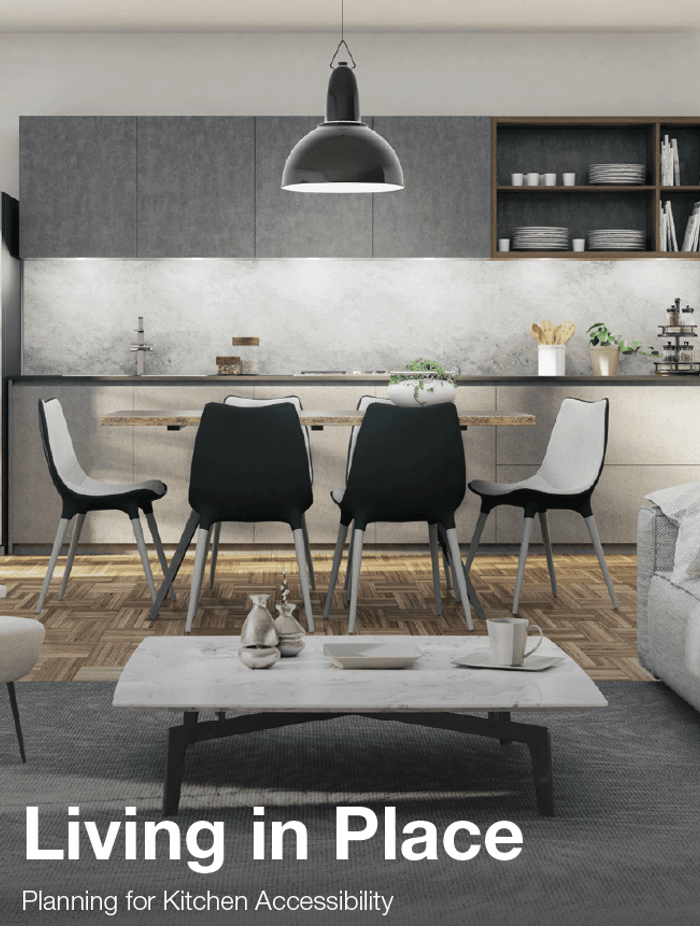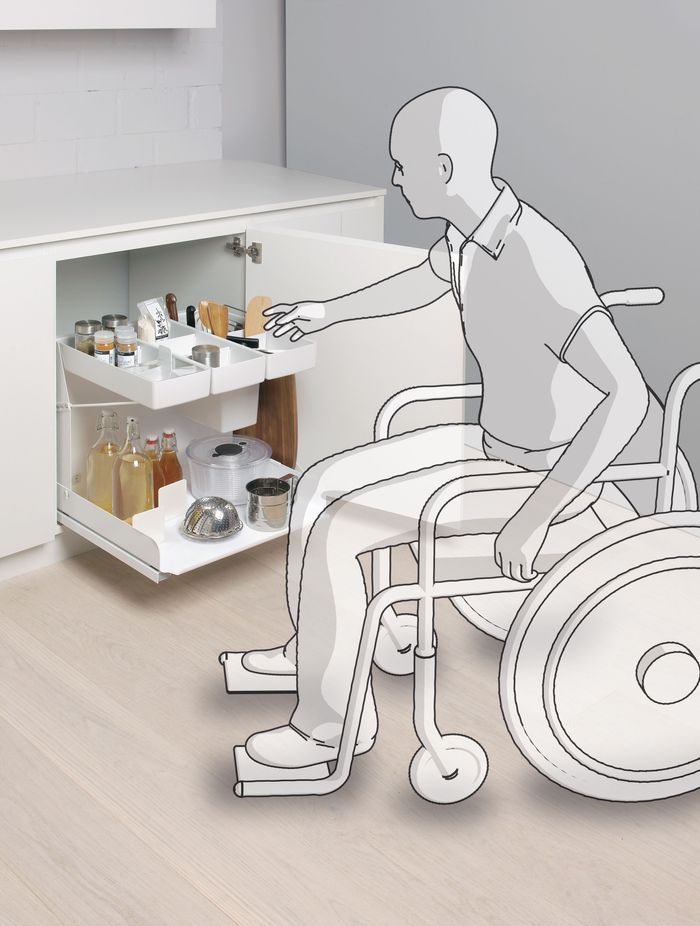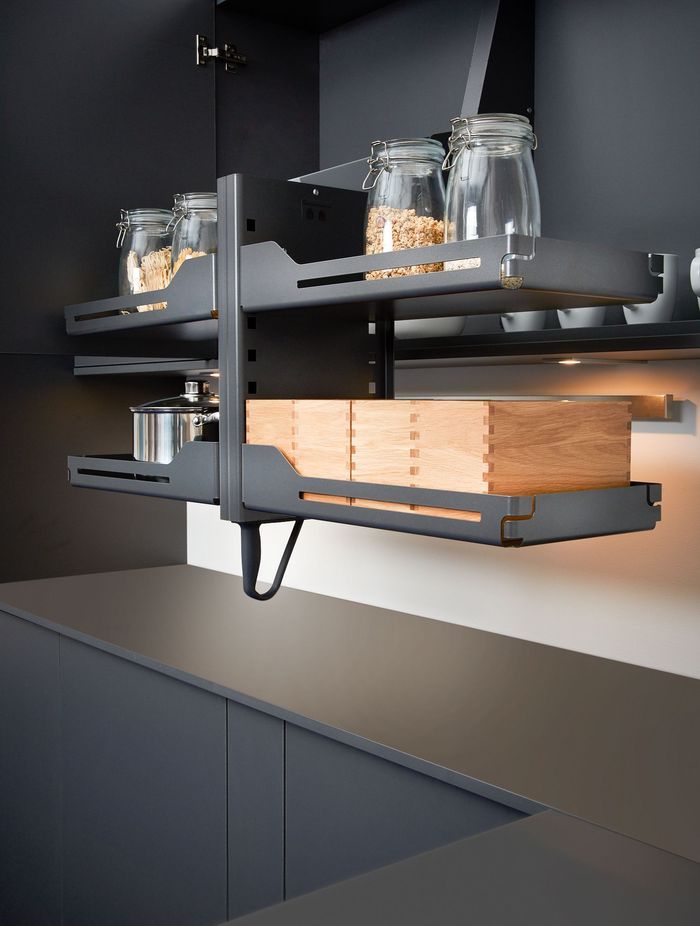LIVING IN PLACE - PLANNING FOR KITCHEN ACCESSIBILITY


Many older Australians say that they desire to 'age in place'. The Australian Housing and Urban Research Institute estimates that between 78 and 81% of Australians aged 55 years or older, depending on their age cohort, want to live in their own home as they age rather than entering specialised aged care. People want to maintain a sense of community, privacy and independence – experiences that are better provided for in one’s own home, and all of which are needed to remain happy and healthy, well into old age.
As we grow older, daily tasks that were once second nature can become difficult and time-consuming due to reduced mobility and advancing medical conditions. Specific architectural details and design elements can help ensure a home is safe, functional and suitable for the needs of individuals aging in place as independently as possible. If these factors are not considered early in the design phase, the homeowner will face costly modifications in the future.
One of the most important spaces in ageing-in-place design is the kitchen. It is one of the most used rooms in the home – a space where people prepare and eat meals, connect with family and entertain guests. The kitchen must not only meet the functional needs of its users, but it must also address their lifestyle and aesthetic preferences. Achieving a balance of accessibility and style ensures a kitchen will bring joy and happiness to its users for their entire lifetime.
DESIGN PRINCIPLES FOR AGEING IN PLACE
Whether called independent living, barrier-free, or aging-in-place design, the goal is to create living spaces that are universally accessible. All these design philosophies are firmly rooted in the principles of universal design, which focuses on designing environments that are safe and comfortable for any age. This broad approach accounts for the physical and mental difficulties faced by occupants as they age, and allows you to create a space that will not need adaptation or functional changes in the future.
The seven key principles of universal design are summarised below:
- Principle 1: Equitable Use. The design is useful and marketable to people with diverse abilities.
- Principle 2: Flexibility in Use. The design accommodates a wide range of individual preferences and abilities.
- Principle 3: Simple and Intuitive Use. The use of the design is easy to understand, regardless of the user's experience, knowledge, language skills, or current concentration level.
- Principle 4: Perceptible Information. The design communicates necessary information effectively to the user, regardless of ambient conditions or the user's sensory abilities.
- Principle 5: Tolerance for Error. The design minimises hazards and the adverse consequences of accidental or unintended actions.
- Principle 6: Low Physical Effort. The design can be used efficiently and comfortably and with a minimum of fatigue.
- Principle 7: Size and Space for Approach and Use. Appropriate size and space is provided for approach, reach, manipulation, and use regardless of the user's body size, posture, or mobility.
These principles are reflected in the Livable Housing Design (LHD) Guidelines.3 The LHD Guidelines assist the residential building, property industry and governments to better understand how to incorporate easy living features into new housing design and construction. Three levels of performance are provided (Silver, Gold and Platinum), which can be voluntarily applied to all new dwellings.
The LHD Guidelines emphasise designing homes that are safer, more comfortable and easier to access for everybody, at all stages of life. Design elements for kitchen spaces are included to support ease of movement and easy adaptation and provide useful guidance for designers and specifiers.

Accessible kitchens should have sufficient clear floor area to enable a person using a wheelchair or with limited mobility to move freely and work effectively.”

BALANCING FUNCTIONALITY AND AESTHETICS
Without proper attention to aesthetics, housing for older people can become institutional. No one who chooses to age in place should have to sacrifice style for function and safety. Most homeowners want a living space designed around their unique style and taste to retain a sense of satisfaction, ownership and comfort. The design process can enhance the lifestyle of residents through aesthetics. Using carefully-chosen colour combinations, materials and finishes, designers can create an uplifting, welcoming atmosphere, rather than a cold, sterile environment. Finding aesthetically-pleasing accessible furnishings is easier now than ever before. More companies are sensitive to the desires of ageing Australians, offering a selection of functional and attractive solutions that are specifically designed for independent living applications of any style.

LIVING IN PLACE COMFORTABLY AND STYLISHLY WITH NOVER
Spanning a history of 65 years, Nover is a proud Australian-owned and operated company specialising in the wholesale distribution of quality products to the kitchen, joinery and furniture manufacturing sector. Through our continued dedication to excellence and an unwavering focus on innovation, Nover is pleased to supply a wide range of accessible solutions that are perfect fits for barrier-free kitchens and living areas.
PEKA STORAGE SYSTEMS Combining smart innovative storage solutions with Swiss quality since 1964, PEKA helps people with disabilities and elderly people to improve their quality of life and live more independently. The PEKA range includes larder pullouts and corner units, including narrow and thin-walled shelves and divides, that make full use of the space in kitchen units and keeps all utensils and ingredients within easy reach. The Pegasus shelf lift is a premium shelf-lift system that provides easy access to high shelves. Easyclean and accessible waste disposal systems are also available in addition to drawer and wardrobe accessories for dividing up storage space. PEKA’s storage solutions are not just functional and easy to use, they are also attractive. PEKA products are available in a range of modern colourways, including anthracite interior fittings made of coated steel which are a perfect match with wood and other common finishes.
LIFT-UP & DROP-DOWN FITTINGS Nover offers a comprehensive selection of lift-up and drop-down fittings from the high-quality Sugatsune Japan range, including upward-opening flap doors, vertical swing-up, bi-fold, swing-down and lateral openings systems with soft-close, free-stop and lift-assist mechanisms. Multi-purpose fittings, pneumatic lift and drop-down pivot arms from Indaux are also available.
LIGHTING & POWER Nover have developed our own Krome range of attractive and affordable lighting to enhance the look, safety and functionality of any kitchen. While general lighting illuminates the entire space, task lighting mounted under cabinets shines shadow-free light directly at the work surface.
Strip lighting mounted under cabinets or kickboards can add that final touch of style.

